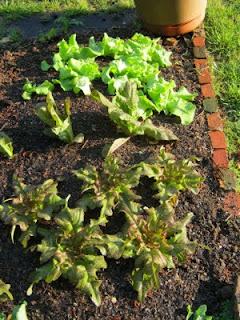
There is still the Slobolt lettuce, but I'm not sure that counts as a spring crop. I've brought in the beets, and the Sugar Snap peas seem to be slowing down in the heat, so I'd say that the spring crops are just about done.
Considering that the daytime high temperatures have gone back into the lower nineties, the persistence of my spring crops has been a little surprising.
Until the traditional summer crops kick in, I am left with chard as a green vegetable from the yard to go with that Slobolt. The good news is that the beans and cucumbers are making good time. In a week or so, they will be ready to add to our meals.
In addition, the onion tops have mostly keeled over, so those have been pulled and left to dry for a day or two on the front porch. The potatoes will be ready to dig soon, too. The domino-like progress of food from the yard into the kitchen, the same almost every year as the seasons progress, is always great to see!
In order to make space in the freezer for any superabundance (I can always hope . . .) we cleaned out the little chest freezer. I usually keep extra flour and cornmeal in there to avoid bug-problems (I tend to buy a LOT when it's on sale), but we moved that into a bucket with one of those "gamma seal" lids (supposed to be bug-proof -- we'll find out!). It turns out that there is a Survival Store surprisingly nearby that sells the lids. If this really works, I might get another one for the rice (usually purchased in 10-20 pound bags, so I don't have to remember to buy more as often).
While working our way to the bottom of the freezer, we did get one pretty big surprise. We still had two gallons of blueberries in there! I had forgotten how productive those bushes were last year. To move those berries along -- one step closer to our stomachs -- I turned most of them into "fruit roll-ups." We already had the dehydrator moved back into the kitchen for the summer, to dry the dill, and making the puree was a snap. We now have 48 pretty large blueberry roll-ups (a.k.a. fruit leather) individually wrapped in wax paper and ready for lunch boxes. I think I'm officially ready for summer!
Since Memorial Day is tomorrow, I'd say my timing isn't too bad.
My Mom (in Oklahoma) usually spends one day during this weekend taking flowers to the graves of family members. I'm betting she's not the only one. Hope it's a beautiful day for everyone, and not too sad.

















